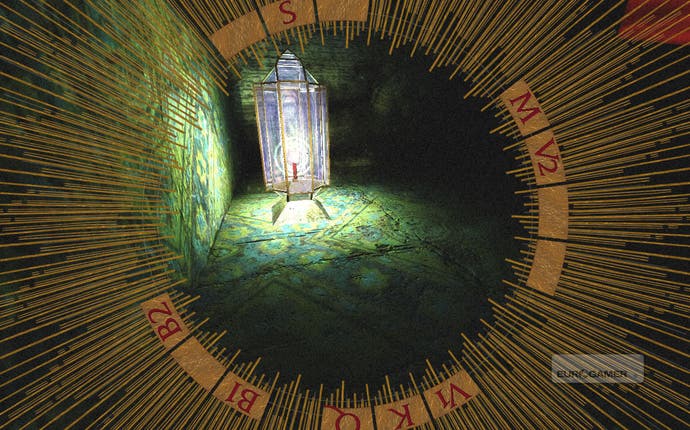Fatale: Exploring Salome
Hide the Salome.
So you're John the Baptist - sell me that one, GameStation - and you're knocking around in a dripping cistern, waiting to be killed. The walls loom closely out of the grey mist, water ripples gently beneath your feet, and a single artful blast of light beams down from above. You're wedged tightly into an awkward variation on the first-person perspective, the viewpoint beloved by disciples of shooting, neck-breaking, and wonky hand-to-hand combat everywhere, but none of that appears to be on the cards today.
The controls are familiar enough, but they're quirky and sluggish. There are crates lying around, but they're only there to mock you for your traditional dependence on crates and the ridiculously handy things you tend to find within them. There's even a jump button: useless, given the circumstances, but still present, like a knotty lump of vestigial tail. Not to worry, all of this stuff is just theatre, really, just false hopes built to reinforce - deep in this dark, wet, underground cell, where your ever-approaching death is already a matter of record in, oh dear, the Bible - just how very screwed you are.
But that's only the half of it, because you're also the player, stuck behind your PC or Mac, wondering what it all means, wondering where it's going, and wondering, possibly, if lurking around the corner there's an on-rails shooting section where you get to take out a Judas Iscariot while clad in a giant amphibious Mech outfit (the answer's no, sadly, but there's always DLC).
Fatale: Exploring Salome's opening third - the John-the-Baptist-waiting-to-die bit - can be a disorientating experience, and one that takes a long time to play out, as you bump around in the dark, kicking at crates, and perhaps stabbing at the keyboard to see if the prophet who foresaw Christ, the patron saint of French Canada and Newfoundland, has picked up any modish parkour skills in his latest incarnation. He hasn't, of course, and the blocks of luminous text sporadically appearing in the air as you wander aimlessly aren't tutorials teaching you how to punch, zip-line, swap weapons, or crouch. They're brief, fairly shrill quotes from Oscar Wilde's interpretation of the story.

Tale of Tales' latest is another GameFAQs disaster, in other words: what do I do? Where do I go? Why won't the door open? How do I get my seven quid back? If Fatale had a hints hotline - and I really wish it did - I'm pretty certain players' calls would be patched directly to Mark Lawson and Umberto Eco, dressed as mimes, answering all queries in Aramaic.
If you're in the wrong mood, it would be possible to take Fatale rather badly: to feel that you're being made fun of, or patronised, and that your decades of accrued traditions - the crates with handy stuff in them, the jumping, the not-getting-killed-in-the-first-scene - are being poked and prodded by people who think that you and your games are stupid and juvenile. But then the door to John the Baptist's cistern opens, and you realise no-one's trying to make fun of anyone, really. The team of art junkies at Tale of Tales possibly love games just as much as a Gearbox or a WayForward, but they're trying to take the form in different directions: to bend it, stretch it, tease it into new shapes. They want to see what it can do.
And it's possible they aren't entirely successful on this outing - certainly not as successful as they were with The Path, mid-March's gothic frolic through the grim fringes of Little Red Riding Hood. Fatale lacks the folk-tale immediacy of The Path, but it lacks the strange coherency of its mysteries, too - it lacks the feeling that behind the horror and the developers' troubling smirks, there was something easily accessible to at least focus your interpretations around.

